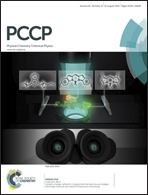Electric field induced hydrogenation of silicene
Abstract
An alternative approach for hydrogenation of silicene is proposed through applying an external electric field in order to reduce the reaction energy barrier based on density functional theory calculations. It is found that a positive perpendicular electric field F can act as a catalyst to reduce the energy barrier of H2 dissociative adsorption on silicene, which facilitates the hydrogenation of silicene. In addition, it is found that the barrier decreases as F increases, and when F is above 0.05 a.u. (1 a.u. = 5.14 × 1011 V m−1), the barrier is quite low and hydrogenation of silicene can take place efficiently at room temperature. The catalytic effect of the electric field on hydrogenation of silicene is induced by the redistribution of atomic charge under the electric field, which would change the chemical activity of silicene significantly.


 Please wait while we load your content...
Please wait while we load your content...